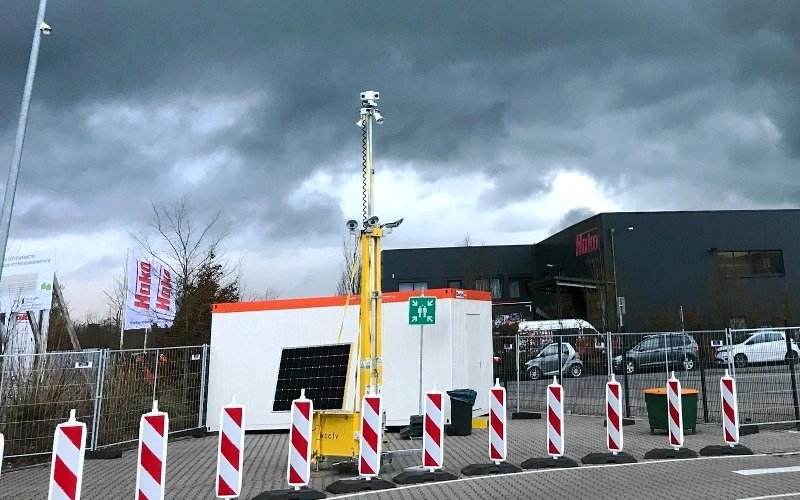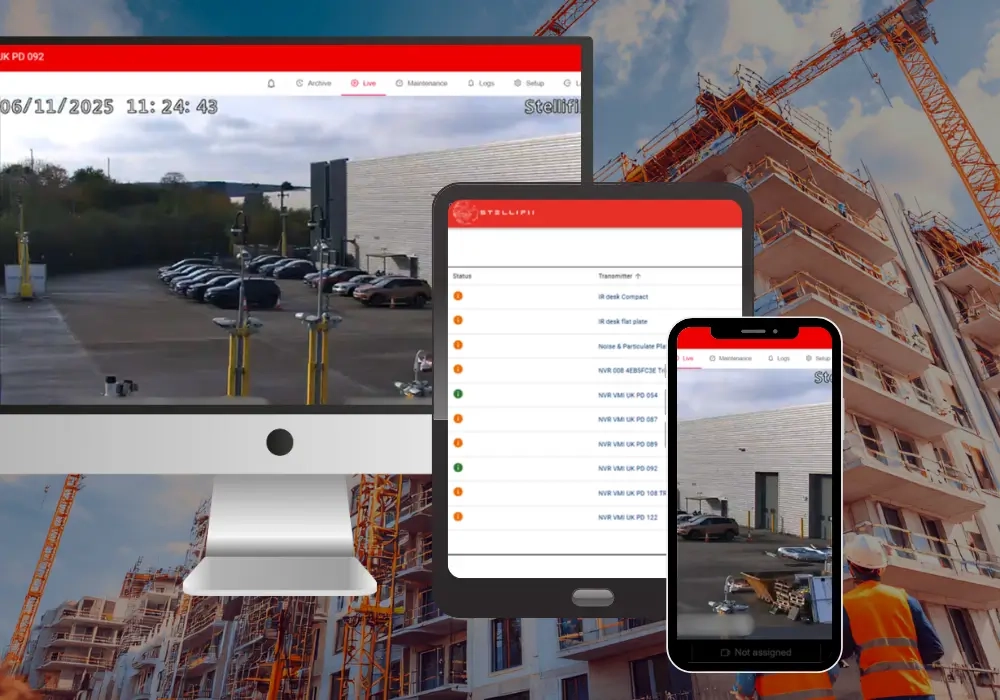Most compliance leaders will understand the struggle of juggling multiple monitoring systems in order to protect your construction site’s safety and security.
Having one to view CCTV footage, one to monitor environmental impact, and another to keep track of on-site visitors, it can be easy to miss errors like a missing noise report. This oversight can lead to delays, reports and complaints, all of which are both financially and reputationally damaging.
All that time spent on filling out spreadsheets, compiling daily reports and responding to small issues end up rolling into tomorrow’s problems. The hidden cost? Lost evenings, weekend admin and the constant worry that something crucial might slip through before your next HSE inspection.
Now, imagine one platform that brings it all together, giving you complete oversight, cutting hours of admin and helping you back up every decision with evidence, not excuses.
In this guide, we'll explore why construction managers drown in system sprawl and how integrated site monitoring solutions deliver measurable return on investment (ROI) through improved efficiency, compliance and control.
Why Construction Project Managers are Drowning in System Sprawl
If you're managing multiple vendors for CCTV surveillance, environmental monitoring and security incidents, you're not alone. The reality? Fragmented systems create chaos rather than control, undermining your authority and eating into the time you should spend leading projects and accelerating business growth.
Fragmented systems
When project updates are scattered across WhatsApp groups, email threads and multiple security tools, accountability quickly disappears. When an incident occurs, you're left piecing together data from different sources while directors wait for answers. That's not project management; that's firefighting.
This system sprawl creates confusion instead of clarity. With no single verifiable source, site managers cannot access real-time data when it matters most. On top of that, each system requires its own login, reporting format and hours of duplicated manual data entry.
Login fatigue
One system for CCTV surveillance, another for environmental monitoring and a third for PPE detection. Before you know it, you're managing a dozen logins just to stay on top of site activity.
Add spreadsheets for compliance tracking and it's a recipe for inefficiency. Every login eats into your time and outdated platforms working in isolation offer no real-time updates or value. Many only record incidents, which leaves construction teams in the dark until footage is reviewed manually - costing more time, money and resources.
By the time you've logged into every system, pulled the data and spotted issues, the impact on schedules and margins has already begun. Manual processes that should take minutes end up taking hours, pulling you away from strategic planning that actually drives projects forward.

After-hours admin
Evenings should be yours, not spent compiling reports from multiple sources. Yet here you are at 9 PM, copy-pasting CCTV data, PPE compliance, environmental reports and site security checklists into tomorrow's director's presentation.
This wasted time and energy leads to stress, frustration and burnout. Your family sees less of you. Your mental clarity suffers. The constant admin grind 5 days a week prevents you from focusing on what you do best: delivering projects on time and within budget.
Compliance pressure
Managers face mounting pressure to comply with safety regulations across the UK's construction industry, including:
-
Construction (Design and Management) CDM Regulations 2015
-
Health and Safety Executive (HSE) standards
-
Health and Safety at Work Act 1974
-
Regional Building Regulations
-
Fire safety protocols
The constant risk of HSE audits creates real anxiety. You're not just managing contractors; you're managing risk, with the threat of fines or reputational damage hanging on every decision.
Resource shortages only add to the complexity. With fewer skilled workers on site, maintaining compliance becomes a daily challenge. Yet directors expect every box to be ticked on tighter budgets.
Read more:
6 Costs of Fragmented Monitoring for UK Construction Sites
The financial and personal costs of system sprawl add up faster than most project managers realise:
-
Time costs: Week after week, hours disappear into admin that should be strategic planning. Pulling reports from multiple security tools, reconciling project data and chasing updates easily steal 1-3 hours every day.
-
Reputation costs: Directors see reactive managers, not proactive leaders. When you're constantly firefighting and explaining what went wrong rather than preventing problems, your professional reputation suffers. The cost of making mistakes due to inefficient processes? Reputational damage that could take years to rebuild.
-
Stress costs: Weekend reporting, after-hour WhatsApp messaging and manual spreadsheet entry create a breeding ground for stress, frustration and burnout.
-
Financial impact: Delayed decisions from fragmented systems result in project overruns. Vandalism, theft and unauthorised access can lead to costly repairs, equipment replacement and timeline delays. One security breach could cost thousands of pounds in direct losses, plus the indirect costs of schedule disruption and insurance premium hikes.
-
Compliance risks: In the UK, penalties for non-compliance are severe. For context, a construction firm in London was fined over £60,000 for multiple site safety failures following an HSE inspection. The ICO can also issue fines up to £17.5 million (or 4% of annual turnover) for GDPR breaches.
-
Career impact: Watching competing construction firms integrating multiple security tools while your firm stays locked in spreadsheet-based workflows puts you at a disadvantage. As the industry evolves, if your technology and security solutions don't keep pace, neither does your career.
Read more: The True Cost of Manual Reporting in Construction
5 Ways Unified Monitoring Delivers Measurable ROI
Moving from disconnected systems to platform consolidation streamlines operations. It transforms how you manage sites, helps reduce costs and proves site monitoring ROI to stakeholders. Here's how:
1. Streamlined reporting
Compiling reports from multiple sources becomes a thing of the past. Automated CDM, HSE and PPE documentation generation means compliance reports appear with a few clicks rather than hours of copy-pasting.
Stellifii, our cloud-based platform, creates one-click exports for director presentations from a single, unified dashboard. Real-time data displays replace time-consuming spreadsheet work. When directors request updates, you can instantly present professional reports showing exactly what’s happening across every site.
Stellifii combines CCTV remote monitoring, environmental monitoring and safety data in one interface. No more logging into countless systems, no vendor sprawl and no manual data entry ever again. This means fewer tools to manage, a significant reduction in costs and improved operational efficiency across the board.
2. Reduced downtime and delays
Temporary CCTV equipped with AI-video analytics, advanced smart detection systems and software monitors work zones both day and night. They help prevent equipment theft and vandalism before security risks escalate into major issues that could halt operations. Standing up to 6 metres tall, our CCTV Towers provide near-360° coverage, delivering complete oversight and peace of mind.
Data-driven decisions from weather monitoring sensors justify site closure notifications with concrete evidence when conditions (e.g. heavy rain, strong winds) become unsafe. Directors can't argue with time-stamped weather data showing wind speeds exceeded safe working limits.
Risk mitigation through early detection prevents the risk of fines or project delays through:
-
PPE monitoring: Signals when workers aren't wearing the appropriate protection gear.
-
Intrusion detection: Identifies and helps prevent unauthorised access before equipment disappears.
-
Smoke and fire detection: Send reliable alerts the moment smoke or flames are identified on site.
-
Air quality monitoring: Tracks CO₂, dust, TVOC, temperature and dew point in real-time.
-
Noise monitoring: Gives accurate decibel readings across your site.
In addition, fully-managed remote monitoring services mean trained security teams watch your site 24/7. When issues arise, they trigger an automated response without the need for human intervention and offer additional support through mobile keyholding and alarm response, who are there to react immediately.
Another benefit of unified site monitoring is that remote diagnostics, through Stellifii, reduces unnecessary site visits, keeping projects moving without delays or human intervention.
Read more: AI-Powered Risk Detection: Smoke, Fire and PPE Compliance in Construction

3. Compliance simplicity
Operational efficiency improves drastically when you remove duplicate reporting and manual data entry. Automated monitoring and reporting for PPE, environmental factors and site activity help you stay compliant with UK regulatory frameworks, keeping your construction projects on the right side of the law, such as:
-
PPE monitoring: Detects and logs workers not wearing PPE, ensuring compliance with CDM 2015 standards.
-
Intrusion detection: Monitors sites 24/7 to prevent access breaches, supporting HSE security guidelines and reducing liability risks.
-
Air quality monitoring: Tracks dust, emissions and particulate matter (PM1, PM2.5, PM10) to help meet ESG and the Control of Pollution Act 1974 regulations.
-
Noise monitoring: Monitors site noise levels to maintain Section 61 compliance and avoid costly enforcement notices.
Stellifii provides time-stamped evidence for every site activity, ensuring accurate audit trails for insurance claims and external inspections. This consolidated approach eliminates vendor and system sprawl, transforming HSE visits from stressful audits into opportunities to demonstrate full compliance.
Read more: GDPR, ESG and Construction: What Every Leader Needs To Know
4. Improved visibility and accountability
Stellifii improves visibility and accountability on UK construction sites by providing an integrated cloud-based platform that combines live video surveillance with AI-powered analytics and environmental monitoring. The platform enables full situational awareness, faster incident response and proactive management of site safety and compliance.
-
AI-powered analytics: Stellifii uses advanced algorithms and machine learning to identify genuine threats from false alarms. The system learns "normal" site behavioural patterns rather than simply detecting motion. This delivers efficiency gains by improving monitoring accuracy and site security.
-
Unified platform: Operations teams can remotely access live and recorded footage, environmental data, system health diagnostics and compliance reports through a single interface from any device. This supports better data-driven decision-making, visibility and operational efficiency.
-
Rapid Deployment and response: Stellifii's wireless setup means you can deploy monitoring devices across even the most complex sites without fixed infrastructure. NSI Gold Accredited monitoring centres provide real-time response to emerging threats, while searchable timelines and exportable reports strengthen accountability for insurance claims and internal audits.
Read more:
-
Our New Platform Transforming Surveillance, Safety & Compliance
-
Choosing a Monitoring Partner That Understands UK Construction
5. Cost savings and risk reduction
The financial impact of a unified platform goes far beyond reduced admin time. Smart systems like Stellifii help prevent costly compliance fines by maintaining continuous oversight of security, PPE and environmental safety protocols.
For instance, a Bristol construction company was fined £27,000+ for 12 noise breaches in 2019. This situation could have been avoided with real-time noise monitoring and automated threshold alerts.
Better incident documentation also helps lower insurance premiums. When insurers see clear evidence of security measures, safety compliance, environment monitoring and proactive risk management, they reward your due diligence with reduced rates. Intelligent integrations such as ANPR, Body Cameras and Time Lapse Video further strengthen your site monitoring efforts.
By consolidating multiple vendors and systems into a single platform, Stellifii reduces operational expenses and complexity: fewer contracts to negotiate, fewer invoices to pay and fewer integration headaches. Our fully-managed services can reduce monitoring costs by up to 88%, accelerating ROI compared to traditional, fragmented setups.
And lastly, the greatest saving is peace of mind. With Stellifii's unified monitoring platform, director meetings, HSE inspections and daily operations all run smoother, backed by data, no doubt.
Read more: Mobile ANPR vs Manned Gate Checks: Accuracy, Cost and Compliance Compared
Consolidate Site Monitoring the Smart Way
In today's construction industry, consolidating site monitoring isn't a luxury; it's a necessity.
By replacing fragmented systems, compliance pressure and endless admin with one unified platform, project managers can focus on what matters most: delivering projects on time and within budget.
Relying on disjointed or redundant tools, spreadsheets and WhatsApp updates makes it easy for something crucial to slip through the cracks, leading to fines, reputational damage and unnecessary stress.
With over 20-years of site monitoring experience, Stellifii simplifies it all. Our all-in-one platform creates a system for security, safety, compliance, project management and condition monitoring in one place.
Whether you're managing civil engineering, residential, or demolition projects, Stellifii delivers a smarter, more connected way to monitor your sites.
FAQs
What are the benefits of a unified site monitoring platform?
A unified site monitoring platform streamlines operations by combining security, safety and environmental monitoring into one system. This reduces admin time, improves compliance, cuts costs, and provides real-time visibility and accountability across your entire construction site.
What does "return on investment" in site monitoring mean?
“Return on investment” in site monitoring simply means getting more value back than what you put in. A unified platform helps you save time, cut admin costs, avoid fines, lower insurance premiums and keep projects running smoothly, all of which add up to real, measurable returns for your business.




